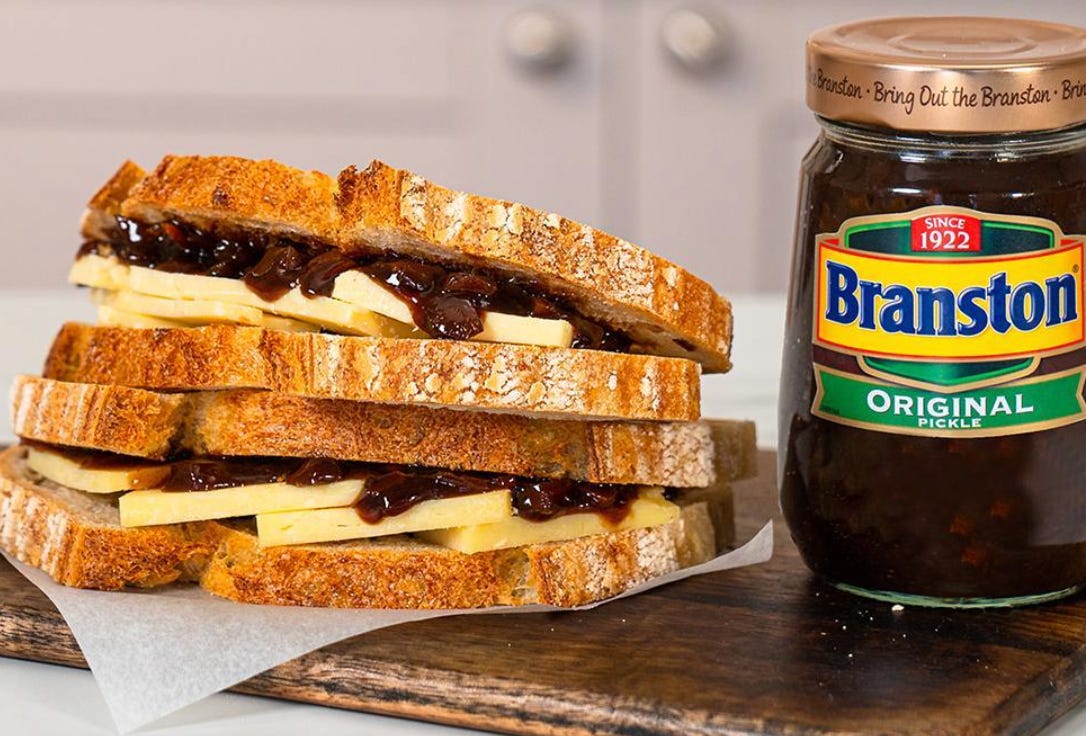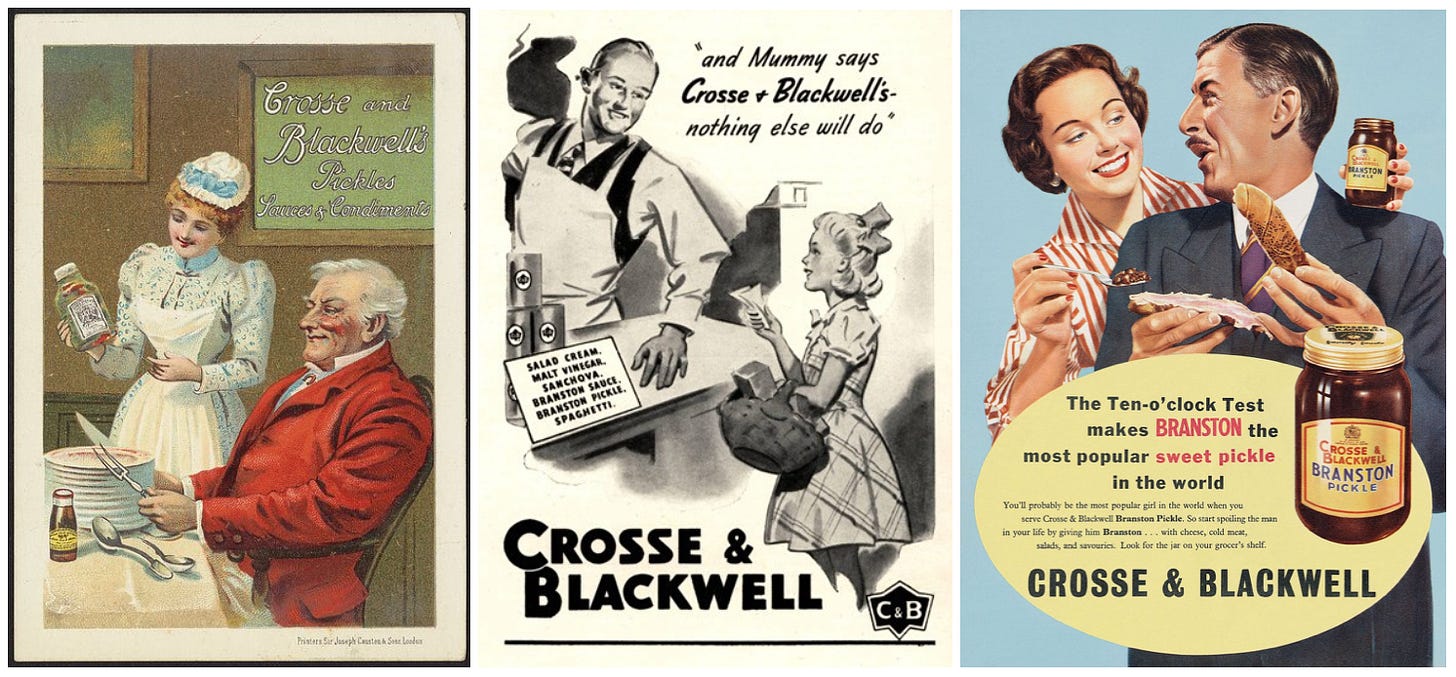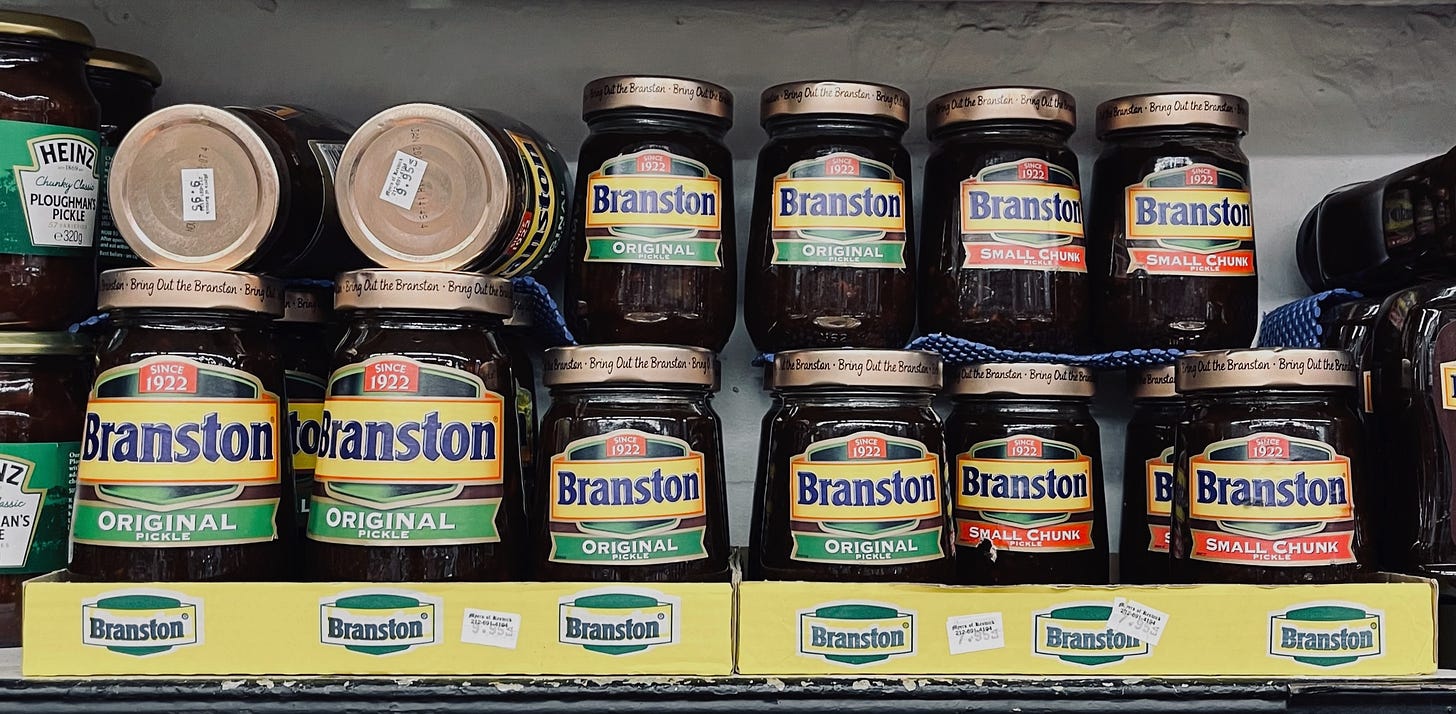Welcome back to Notable Sandwiches, the series in which I, alongside my editor David Swanson, trip merrily through the profoundly odd and ever-changing document that is Wikipedia’s List of Notable Sandwiches. This week, David explores his British heritage through the iconic cheese-and-pickle sandwich. — Talia
I come to this sandwich from a place of experience: while I’ve lived most of my life in New York City, I was born in Scotland, and returned there for college. I’ve eaten my share of British food, and still crave a Sunday Roast, or a full Scottish, Irish, or English Breakfast. I miss the ubiquity of a chip-shop on the corner, and a strong cup of tea in the afternoon. I miss real haggis. But well and truly, the British food I’ve returned to most often since my own personal Brexit is the cheese and pickle sandwich. In fact, it’s in contention for a spot on my list of desert island comfort foods. And this long hot terrible week, I needed it.
A note for our stateside readers: the “cheese and pickle sandwich” suffers in Transatlantic translation. There’s no dill-pickled cucumber spears or bread-and-butter chips involved, and heaven forbid the cheese be of the “American” variety. A proper cheese and pickle is an exceedingly simple thing, but it is also an exceedingly British thing, and the particulars are sacrosanct. The cheese should be cheddar, the sharper the better. The bread should be hearty, crusty, and fresh. And the pickle should be—must be—Branston.
Branston Pickle was born one hundred years, to Mrs. Caroline Graham of Branston Lodge in Burton-on-Trent, Staffordshire, England. Mrs. Graham had developed the recipe along with her daughters Ermentrude and Evelyn, the latter of whom worked as a biological researcher; it called for twenty-three ingredients, including onions from Holland, lemon juice from Sicily, rutabaga seeds from Canada, dates from Pakistan, and gherkins from India, all sourced from the sprawling produce market in London’s Covent Garden. This proprietary concoction—closer to an Indian chutney than anything we would call a “pickle” on this side of the Atlantic—was spicy, savory, crunchy, and sweet. In 1922, Crosse & Blackwell, the august British food-preservation concern established in 1706, began producing jars of Mrs. Graham’s pickle, and named it Branston, after the village. And then, sometime soon after, an unnamed hero combined pickle with cheese, smooshed it between two pieces of bread, and secured their place in the pantheon of British genius.
The cheese and pickle has been called Britain’s favorite sandwich, its most iconic, its most… British. I wouldn’t disagree. Its simplicity belies the way it spans and embodies the breadth of British influence and history. Essentially a Ploughman’s Lunch in sandwich form, it is best eaten over a strong ale at an ancient pub (named something like “The Cheese & Pickle”) or on a picnic after a wander on the moors. It calls for a particular variety of cheese first produced almost a millennia ago, 140 miles south of Branston in Somerset’s Cheddar Gorge—a cheese which happens to be Britain’s most popular (possibly its most popular food, period.) The sandwich also requires a condiment that reflects the reach of the British Empire in its composition (ingredients from far-flung locales, made to a recipe inspired by the Raj), and which reflects the wonders of Britain’s Industrial Revolution in its production (food preservation technologies, mechanized manufacturing). I can think of few other quintessentially “British” offerings that embody such a wide swath of the island’s culture and history.
It also embodies a healthy chunk of my own history. I, sadly, have no memories of Branston from childhood. I was two years old when my parents returned to America from Scotland, and my only taste memories those early years are Weetabix and shortbread. I fell in love with the sandwich years later, as a college student without much in my wallet most of the time. It quickly became a staple in an otherwise atrocious collegiate diet. The sandwich was cheap—not even the finest block of cheddar or loaf of bread are going to set you back much, and a jar of Branston cost less than a pound in my uni days—and was so simple even a young inebriate could manage to slap one together after an evening down the pub.
Today, after two decades spent back in New York, I still keep at least one jar of Branston on hand, often purchased at Myers of Keswick, on Hudson Street in Greenwich Village, the neighborhood where I spent most of my childhood. At Myers, they carry all three varieties of Branston Pickle: original (chunky; best with cold meats); small-chunk (my go-to; great for sandwiches); and smooth (revolting; I’ve never tried it). The jars are stocked next to the Heinz Baked Beans, and below the canned haggis. My other go-to spot is a few blocks away, at Tea & Sympathy on Greenwich Avenue, where owner Nicky Perry has been serving cheese and pickle sandwiches to homesick British expats and curious American tourists since 1990.
“It’s been on the menu right from the very beginning, 32 years ago,” she tells me. “When all the Americans go, ‘what is this?’ I go, ‘well, that’s Branston Pickle. You can buy it right next door in my shop.’ They love it.” At Tea & Sympathy there are a number of variations to choose from: they offer a main-course sandwich, as well as daintier versions for afternoon tea service, and you can choose between three types of bread. But the pickle has to be Branston, and only the original, large-chunk variety. “It’s an English staple,” says Perry. “I bet even the Queen’s got that in the larder.” (Buckingham Palace could not be reached for comment.)
The Sword and the Sandwich is a newsletter about serious extremism and equally serious sandwiches. Please consider supporting this work with a paid subscription:
Ms. Perry is “not so fussy” about the bread as long as it’s fresh, preferring slices of white or a white roll. I usually make mine—quel horreur!—on a baguette, which I’ll claim is a nod to the enduring legacy of the Norman Conquest on Britain’s cultural and culinary history. This week, with its heat wave and sour news, was a serendipitous time to be writing about one of my most reliable comfort foods. This wouldn’t be a proper Notable Sandwich column if the historical arcana wasn’t cut with a dash of self-reflection and psycho-babble, so let me just say this has been a shitty week. It started badly on Monday, when I learned that I wouldn’t be hired for a job I had my heart set on. It got far worse two days later, when I learned that one of my oldest family friends had passed away after a long illness. Almost a decade ago, he helped me get sober, and changed my life. Fifty years ago, his life was changed by a loaf of fresh-baked bread: during a wild streak of long-haired hedonism, he stopped for a loaf at a Trappist monastery, and wound up staying there for seven years. It’s one of my favorite stories about him. Thank God for fresh bread. Thank God for comfort food.
On Thursday morning, I was listening to an interview with the distractingly British comic (and food podcaster) James Acaster, in which he discussed his countrymen’s tendency towards psychological repression, and aversion to therapy or analysis. I wonder if that disposition helps explain why British cuisine is so laden with heavy, filling comfort foods, from Sunday Roast Dinner or shepherd's pie to beans on toast or full-on fry-up. Perhaps it’s also why drinking is such an important component of British cuisine and culture: On that list of most popular “foods” in Britain, cheddar cheese comes in at number three; the top two spots are both whisky. Thankfully, I don’t drink anymore, so if I’m craving a taste of Britain, and seeking to assuage my sorrow, I tuck into the familiar pleasures of a cheese and pickle sandwich.









Oh, this brings back memories of growing up in England! "Bring out the Branston!" chanted the TV commercial, like soccer fans at a match, cheering for their team. Sunday afternoon, crusty white bread, room temperature butter, a block of sharp and slightly crumbly aged cheddar cheese, and a big jar of Branston original. Heaven!
I saw some Branston Pickle at World Market and thanks to this column, I bought said pickle, made the cheddar and pickle sandwich and it was so good! I got a paid subscription just so I could comment and tell you how much I enjoy the sandwiches and the swordplay.